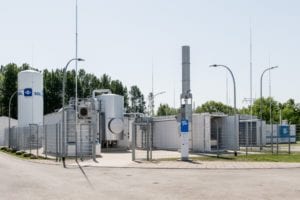
Uniper
After the power-to-gas plant in Falkenhagen, Brandenburg, was expanded by a methanation stage in May 2018, synthetic natural gas (methane) has recently been fed into the natural gas grid. This allowed the partners of the international research project STORE&GO to demonstrate the technical feasibility of the power-to-gas process through methanation, using electrolysis, for feeding the “green” gas into the natural gas grid. So far, pure hydrogen has been fed into the natural gas grid of the power-to-gas plant in Falkenhagen. Today, the plant produces up to 1,400 m3/d of synthetic methane (SNG), which corresponds to approximately 14,500 kWh of energy. With this amount of energy, 200 golf class CNG cars could drive about 150 km7d. The methanation is designed for continuous operation and constantly achieves a very high quality of feed. To produce the green methane, the regeneratively produced hydrogen is converted to methane, with CO2 in a bioethanol plant. The heat generated during the process is also used by the neighboring veneer plant.
“Green methane” can make an important contribution to the success of the energy transition in the future. Wind and solar energy are subject to strong natural fluctuations in their availability, which can lead to the shutdown of such generating plants at peak times. Therefore, great potential for supplying the country with natural and cheap electricity can be lost. Green methane closes this gap. It can be used in many ways, for example as a fuel, to generate heat and electricity in power plants or at home and as a raw material for the chemical industry. At the same time, the unrestricted use of existing natural gas infrastructure opens up new opportunities for the transport and storage of energy generated from renewable sources. The stored energy is always available as needed, even when the sun and wind are not available to the required extent.
In the STORE&GO project (www.storeandgo.info), 27 partners from six countries are working together to investigate the possibilities of integrating power-to-gas applications into the European energy network and, above all, to promote the methanation of hydrogen as an important component of an integrated energy transition.
The plant was realized by the operator, Uniper (Düsseldorf, Germany; www.uniper.energy), in collaboration with the location partners, Thyssenkrupp Industrial Solutions (Essen, Germany; www.thyssenkrupp-industrial-solutions.com), DVGW Research Center at the Engler-Bunte Institute of KIT and the Institute of Chemical Energy – Fuel Technology of the Engler-Bunte-Institute at KIT, as the process developers. In the coming months, further work will be carried out to test and optimize the technology and operational experience will be gained.
Eckhardt Rümmler, COO of Uniper, says: “The gas network and gas storage are the only available technology in the long run to store large volumes of renewable energy seasonally. At the same time, power-to-gas contributes to reducing CO2 emissions by using carbon dioxide as a raw material for methane extraction. In order for the technologies to be able to reach their full potential in the future, a gradual conversion of the natural gas network to green gas is required. Crucial prerequisites for this are that the electricity used is exempted from consumer charges and that the CO2 savings in the transport and heat sectors are taken into account.“
Helmut Knauthe, chief technology officer, thyssenkrupp Industrial Solutions, says: “With the successful start-up of our methanation plant, science and industry have shown that the storage of renewable energy is possible on a large scale through power-to-gas. Now it is a question of creating the appropriate framework conditions for comprehensive system solutions together with politicians and answering infrastructural questions. Further development of the technology creates industrial policy opportunities and can secure long-term competitive advantages in Germany and Europe.“
Professor Thomas Kolb, Karlsruhe Institute of Technology (KIT) says: “From electrolysis to wind energy, through methanation to distribution and storage, the PtG pilot plant in Falkenhagen now maps all the steps in the power-to-gas process path. With the successful direct feed into the natural gas network, we have shown that the climate-friendly power-to-gas technology is ready for technical use. We were able to make a significant contribution to this with our innovative honeycomb reactor.“
For more on power-to-x, see Chem. Eng., January 2019, pp. 14–17; www.chemengonline.com/power-x-batteries-not-required.